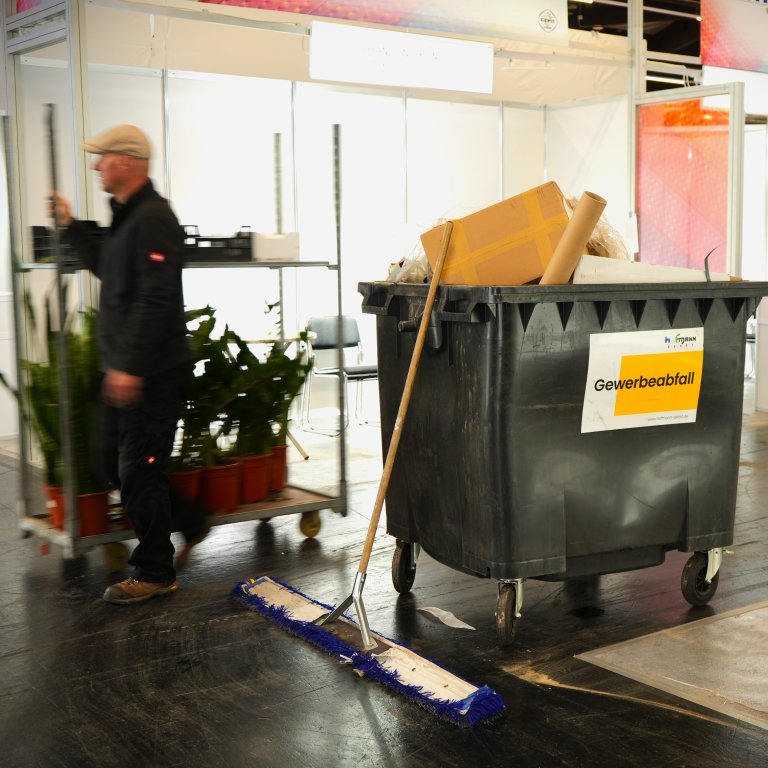-
Solar power has been flowing from the roofs of the exhibition halls since 1 December
-
By the final construction phase ending in May 2024, 21,000 solar panels will achieve an output of around 9 MWp (megawatt peak)
-
Artificial intelligence (AI) ensures efficient load management
-
The goal is a CO2-neutral energy supply by 2028
For the first time, this year’s Christmas tree in front of the entrance of Exhibition Centre Nuremberg will be lit up using the centre’s own solar power. Just in time for the Christmas season, NürnbergMesse will start producing the first green electricity from its own photovoltaic (PV) system. To do this, around 12,700 solar panels have been installed on the roofs of exhibition halls 3, 3A and 3C and the multi-storey “Nord” car park since March this year. The solar panels on top of halls 3A and 3C are already providing 1.9 MWp that is being fed to the power grid. By the summer of 2024, NürnbergMesse will have installed a total of around 21,000 solar panels on seven exhibition halls and the multi-storey car park, to then reach a total output of around 9 MWp. Its capacity of around 9 million kWh a year can supply a town with more than 7,000 residents (around 3,600 two‑person households). This means that in a single complex of buildings, NürnbergMesse will have the largest photovoltaic system of any company in which the State of Bavaria is a stakeholder. For the first construction phase for the solar power system including innovative second-life battery storage, NürnbergMesse expects to invest around €15 million in total.
“The commissioning of the solar power system is a milestone for NürnbergMesse on its path to CO2-neutrality. The system is an absolute showpiece and is making an important contribution to the energy transition – not just for the State of Bavaria, but also for the German trade fair industry,” Albert Füracker, Bavarian Minister of Finance and Home Affairs and deputy chair of the NürnbergMesse supervisory board. Nuremberg’s mayor Marcus König, the chair of the supervisory board of NürnbergMesse, expands: “By producing its own solar power, NürnbergMesse is resolutely continuing its path to sustainability, while at the same time setting a strong example for climate protection in the city and metropolitan region of Nuremberg!”
In March, the managing directors of NürnbergMesse joined with Bavarian Premier Dr Markus Söder, Minister Füracker and Mayor König to officially launch the construction of the solar power system at the exhibition centre. The focus of the project is to make optimum use of the energy produced in-house. This will be achieved by using modular second-life battery storage units from test vehicles with a total output of 7.7 MWh as short-term buffer storage, ensuring that energy is being reused. As a result, NürnbergMesse can significantly increase its share of in-house generation and use around 75% of the solar power generated itself. This results in a self-sufficiency level of up to 30 percent relative to the previous total power consumption.
“With the PV system we have made a major step towards having a completely CO2-neutral energy supply by 2028,” explains Peter Ottmann, CEO of NürnbergMesse. Ahead of today’s regular supervisory board meeting, Ottmann, together with chairman Marcus König and his deputy Albert Füracker, received and started up the all-important battery storage system. By May 2024, an additional 3.7 MWp will be fed to the grid thanks to the solar panels on the roofs of exhibition halls 3 and 11 and the multi-storey “Nord” car park.
Artificial intelligence and expansion plans
NürnbergMesse is also relying on artificial intelligence in conjunction with the installation of the solar power system. The trade fair company worked with its system planning partner HEITEC Innovation GmbH to develop what is known as a “digital twin”, which will enable efficient load management in the planning and operation of the system.
Before the last PV modules (for the time being) are installed by the summer of 2024, NürnbergMesse is already thinking about its next move: the expansion of the PV modules to around 20 MWp, which would then allow up to a total of 20 million kilowatt hours of electricity to be generated. This would be equivalent to the consumption of a small town with around 20,000 inhabitants.
Hall lighting: 100% LED
By last summer, NürnbergMesse had already finished switching the lighting in all exhibition halls to LEDs. In the process, more than 21 km of fluorescent tubes were replaced by energy-saving LED lights, allowing NürnbergMesse to save around 80% energy compared with the previous fluorescent tubes.
Sustainability goals
With its large-scale use of energy-saving LED lighting and the installation of the PV system, NürnbergMesse is also contributing to the UN’s sustainable development goals (SDGs) such as goal 7 (affordable and clean energy), 9 (industry, innovation, and infrastructure), 11 (sustainable cities and communities) and 13 (climate action). Thanks to electricity from its own solar power system, the company will be saving about 7,500 tons of CO2 annually from the summer of 2024.





